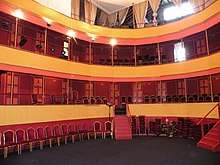Theatre Royal, Barnwell, Cambridge
The Theatre Royal was built in the Barnwell suburb of Cambridge, England, in 1816. It closed later that century but reopened as the Cambridge Festival Theatre from 1926 until 1935. The building, in which part of the interior of the theatre survives, is Grade II* listed.

19th century
William Wilkins (1751–1815)[1], a building contractor, was proprietor of a chain of theatres in East Anglia known as the Norwich circuit. Performers included the Norwich Company of Comedians, and performances had been given since the late 18th century on Stourbridge Common, north of the city of Cambridge, at the annual Stourbridge fair.[2] Wilkins and his son, also William (1778–1839), built a theatre in 1807 at Sun Street, Barnwell. The younger Wilkins – a prominent architect who had designed Downing College and went on to work at other colleges and the National Gallery – designed a new theatre nearby to replace the 1807 building.[3]
The building is on the south side of the Newmarket Road in the northeastern Cambridge suburb of Barnwell. Completed in 1816, the theatre was sited outside the boundary of the town owing to prohibition of theatrical entertainment by the University authorities[4] (a 1737 act "for the More Effectual Preventing the Unlawful Playing of Interludes within the Precincts of the Two Universities ..." forbade the performance of all plays and operas within five miles of the town).[5]
On his father's death in 1815, Wilkins inherited the leases of the new site and six other theatres – Norwich, Bury St Edmunds, Colchester, Yarmouth, Ipswich and King's Lynn[6] – and continued to run them. Proprietorship passed to his son, W Bushby Wilkins, and a succession of lessees, but the Norwich circuit declined.[7] The theatre closed in 1878 and became a nonconformist chapel.[8]
Cambridge Festival Theatre
Terence Gray (1895–1986) leased the building in 1926 and reopened it as the Cambridge Festival Theatre. The alleyway between the street and the building was enclosed to form a foyer. The interior was modernised, with the proscenium arch widened by the removal of the private boxes,[9] and the introduction of electric lighting, a brick cyclorama and an early example of a revolving stage.[4] The theatre was the country's "first permanent indoor performing space to be based on the design of a Greek open-air theatre".[10]
The 'Festival' name reflected Grey's intention (unfulfilled) to promote summer festivals.[9] The opening production on 22 November 1926 was Oresteia, with choreography by Ninette de Valois.[10]
Grey retired from the theatre in 1933[8] and went on to write on Taoism under the pseudonym "Wei Wu Wei". Norman Marshall worked at the theatre from 1926 and was its director from 1932 to 1933.
From 1927, Joseph Macleod was an actor and producer at the theatre, and in 1933 he became the theatre's director and lessee. Five of Macleod's plays were staged there, including Overture to Cambridge (1933) and A Woman Turned to Stone (1934). Under Macleod, the theatre became known for its avant-garde productions, and staging of lesser known works by great playwrights. Macleod staged some of Ezra Pound's Noh plays, and also some Ibsen and Chekhov (his company, The Cambridge Festival Players, was one of the first in the UK to stage Chekhov's play The Seagull). The theatre was obliged to close due to financial difficulties in June 1935.
The building was recorded as Grade II* listed in 1950.[4] From 1962 it was used by the Arts Theatre as a workshop and store.[8]
Today
The building is in use as a Buddhist centre.[11]
Historic England describe the interior as "a virtually complete example of a Georgian theatre with a three-tiered horsehoe auditorium with the galleries supported on cast iron columns." and state that a painting of the Royal Arms remains above the proscenium.[4]
References
- Searby 1988, p. 699.
- Searby 1988, p. 693.
- Searby 1988, p. 701.
- Historic England. "Arts Theatre Workshop and Store (1126148)". National Heritage List for England. Retrieved 26 September 2018.
- Searby 1988, pp. 696–700.
- Searby 1988, pp. 696–701.
- Searby 1988, pp. 696–706.
- Davies, Andrew John (17 January 1995). "The Festival Theatre, Cambridge". The Independent. Retrieved 26 September 2018.
- Rhona Justice-Malloy (9 August 2009). Theatre History Studies 2009. University of Alabama Press. pp. 171–198. ISBN 978-0-8173-5554-8.
- P. E. Easterling (2 October 1997). The Cambridge Companion to Greek Tragedy. Cambridge University Press. p. 305. ISBN 978-0-521-42351-9.
- "Cambridge Buddhist Centre". Retrieved 26 September 2018.
- Searby, Peter (1988). A History of the University of Cambridge: Vol 3: 1750–1870. Cambridge University Press. ISBN 978-0-521-35060-0.</ref>
External links
- Visit to the theatre, 2016
- Cambridge Festival Theatre, Marlowe Society – archived on 9 January 2014